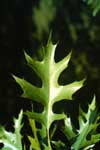Quercus palustris
 |
 |
 |
|
Pin Oak |
Pin Oak in winter |
Leaf of Pin Oak |
Summary
Foliage: Deciduous broadleaf
Height: 60 to 70 feet
Spread: 25 to 40 feet
Shape: Upright
The glossy, dark green summer foliage changes to bronze or red in the fall. The light brown acorn is 1/2-inch long and wide.
Plant Needs
Zone: 4 to 8
Light: Partial shade to full sun
Moisture: Wet to moist
Soil Type: Sandy, loam, or clay
pH Range: 3.7 to 6.0
Functions
Suggested uses for this plant include shade and specimen plant.
Planting Notes
Readily transplants due to fibrous root system. Prefers moist, rich, well-drained acid soil and full sun. Don't plant in high pH soils. Tolerates wet, clay soils. Moderately tolerant of city conditions.
Care
Prune to establish one central leader (trunk). Take care to maintain adequate soil condition. (more)
Problems
Grows poorly in soil with high pH. Otherwise, no serious pest or disease problems.
Alternatives
Consult local sources, including historic or public gardens and arboreta, regarding cultivars and related species that grow well in your area.
Cultivars of QUERCUS PALUSTRIS
`Sovereign' has lower branches that do not droop.
`Crownright' is similar to the `Sovereign', but with a more narrow and upright shape.
Comments
The branching habit of the native Pin Oak is truly unique. The upper branches are ascending, the middle ones horizontal, and the lower ones drooping. The drooping lower branches make Pin Oak a poor street tree. It is better placed in locations where the lower branches will not be a nuisance. Suitable for bonsai.
This material was developed by Carol Ness as part of the Interactive Design and Development Project funded by the Kellogg Foundation. Mary Miller, Project Director. Diane Relf, Content Specialist, Horticulture. Copyright 1989 by VCE.

